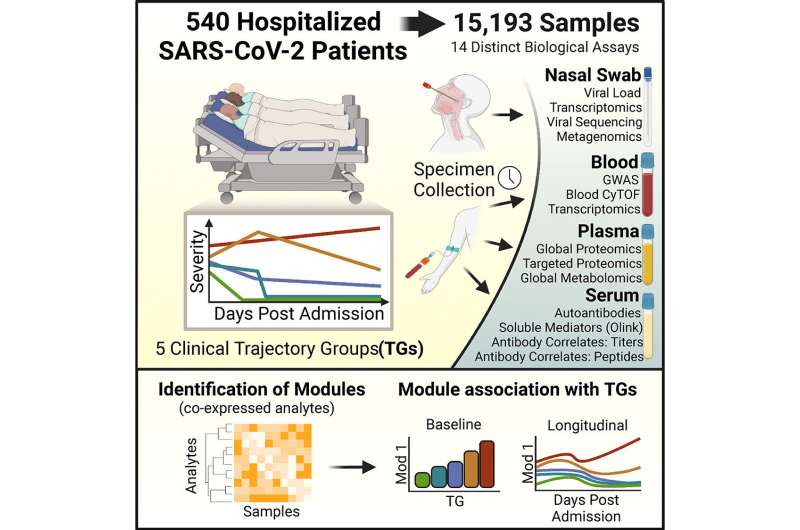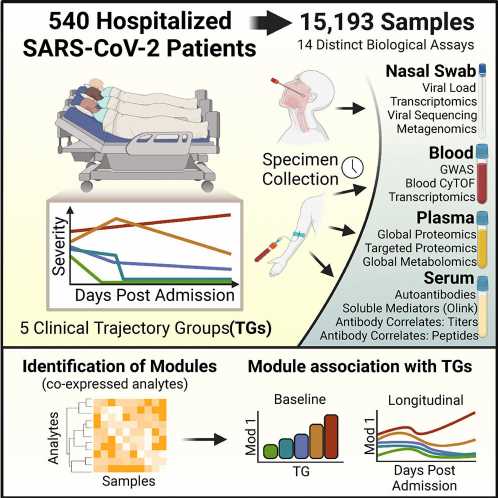
Scientists have now made substantial progress in predicting the path that COVID-19 will take in patients, finding sets of biological features that are associated with the course and severity of COVID-19. The findings were recently published in Cell Reports Medicine by researchers from Drexel University’s College of Medicine, Boston Children’s Hospital, Yale, and other institutions nationwide.
Researchers followed the participants—540 adult COVID-19 patients from 20 hospitals nationwide—for up to 28 days after they entered the hospital. The team’s data collection included 14 unique lab tests using nasal swabs, blood, plasma, and serum samples. Through the data collection, the team found five categories of paths that COVID-19 cases take, ranging from mild to severe cases that end in death. The findings should help clinical teams understand which COVID-19 patients are at higher risk of death and likely require swift and aggressive care to meet unique individual needs.
“Thanks to the massive data analysis in this study, researchers now know factors at both the cellular and molecular level—that are associated with severe COVID-19 disease and death,” said study co-author Charles Cairns, MD, the Walter H. and Leonore Annenberg Dean, and senior vice president of medical affairs at the College of Medicine. “These factors that predict more severe disease—higher viral load and higher inflammatory pathways in the airway—appear in patients fairly quickly—within three days after admission to the hospital.”
The team looked at more than 15,000 blood and nasal samples for factors like possible indications of muscle damage, increases in white blood cells, changes in cells that line airways, and other factors that indicate increased inflammation and lower immunity, and less anti-viral response to fight the disease.
“What’s interesting is the association of delayed clearance of viral load—less ability to rid the body of the virus—despite having working antibodies, with death from COVID-19,” said co-author Elias El Haddad, Ph.D., a professor in the College of Medicine. “Of course, we know COVID-19 vaccines work, but they’re not the only factor at play in determining the path of disease. Different antibody response, among other factors, appears to play a noteworthy role.”
The findings are the latest data coming from the IMmunoPhenotyping Assessment in a COVID-19 Cohort, or IMPACC, a national study that collected data from COVID-19 patients going back to the early days of the pandemic in 2020. This systems approach to data collection—analyzing the interplay of a broad range of factors that influence the disease—should inform research to come on other pandemics.
The authors note that future studies would benefit from data on pregnant women and children, two populations not included in this research. Although participant recruitment occurred before COVID-19 vaccines became available and before delta and omicron became the prevailing variants in the United States, the authors maintain that the insights learned from patients can inform standard practice for treating current patients for COVID-19.
Despite the benefits of vaccines, antiviral medication, and public health measures, COVID-19 still circulates worldwide, but at lower numbers than earlier in the pandemic. The World Health Organization Director General Tedros Adhanom Ghebreyesus placed the death toll to “at least 20 million (worldwide)” but said the pandemic “has been on a downward trend,” as immunity increases and deaths decrease with increasing vaccination and infections.
The U.S. Federal Government’s COVID-19 public health emergency declaration ended on May 11. Now manufacturers of vaccines, tests and the antiviral drug Paxlovid, as well as insurance companies, are authorized to set prices after the current stockpile of free supplies is distributed.
More than 65 million individuals worldwide—including about one in 10 people with a previous omicron infection—are estimated to have chronic symptoms that last for months or a year following a previous COVID-19 infection, a diagnosis known as “long COVID.” Being unvaccinated raises the long-COVID risk to nearly one in five people, according to a BMJ study published last month.
In 2022, Cairns and El Haddad, among many others from this research group, published a separate multi-center study in eBioMedicine that shared some characteristics linked with more severe COVID cases.
More information:
Joann Diray-Arce et al, Multi-omic longitudinal study reveals immune correlates of clinical course among hospitalized COVID-19 patients, Cell Reports Medicine (2023). DOI: 10.1016/j.xcrm.2023.101079
Journal information:
British Medical Journal (BMJ)
,
Cell Reports Medicine
,
The Lancet
Source: Read Full Article
